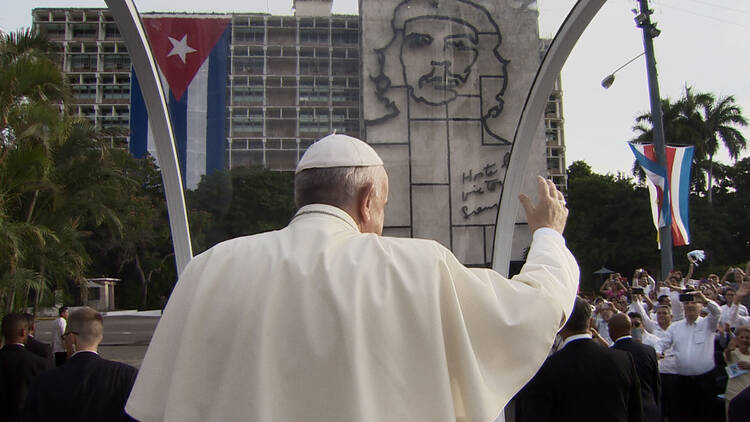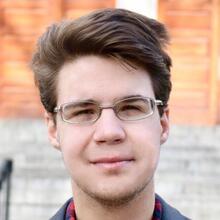Following his portrait of war-torn regions in the Middle East, the Oscar-nominated documentarian Gianfranco Rosi set his sights on one of the world’s most recognizable figures: Pope Francis. During the first nine years of his papacy, the now 86-year-old pope, whom Rosi describes as a revolutionary with a knack for taking risks, traveled widely to 53 countries. (Pope St. John Paul II, who during his 27-year pontificate visited nearly 130 countries, remains the most-traveled pope.)
Accompanying Pope Francis to Malta and Canada, Rosi crafted a surprisingly intimate film using a treasure trove of archival footage chronicling the pope’s many sojourns and exploring the key issues of his papacy. Recently, Rosi traveled with the pope to Africa; he intends to film future apostolic journeys also, creating what Rosi calls “an open film.”
America spoke with Gianfranco Rosi about his ideas for the documentary and how the film is a modern-day Stations of the Cross.
Ahead of the U.S. theatrical release of “In Viaggio: The Travels of Pope Francis,” America spoke with Rosi on March 22 about his ideas for the documentary, his access to the pope and how the film is a modern-day Stations of the Cross. This interview has been edited for clarity, style and length.
America:In Jesuit spirituality, the clergy is called to meet people “at the margins” of society. What do you think Pope Francis’ various journeys reveal about his desire to minister at the margins?
Rosi: This is a pope doing almost an opposite pilgrimage: from inside the Vatican to outside its walls. When we travel, we change. We are not hidden in our bubble. When doing that, we need to step back and be able to embrace the needs of the other people. That’s what this pope does in a very singular way.
I wanted this film to be a portrait of a man more than a portrait of a pope. I wanted to see the pope constantly traveling outside the walls of the Vatican, encountering people that we usually turn away from. The pope is able to make us interact [with these people] in a way that is almost political.
How did you go about contacting the Vatican?
Like all my work, this film happened through an encounter. I met the pope for the first time after I did “Fuocoammare,” which was a film I shot in Lampedusa. This was the first trip he took outside the Vatican. where he encountered the drama of this little island to where people escaped from war, from hunger. Years later, I did “Notturno,” which was filmed in Iraq, Lebanon, Syria and Kurdistan. The pope was taking a trip to Iraq, and I had just finished the film. I did an interview with L’Osservatore Romano that I know the pope read.
‘Like all my work, this film happened through an encounter.’
When he returned from Iraq, I was asked to collaborate on doing something with the footage. I saw this footage, but it was difficult for me to relate to. It was shot for live television, a language that didn’t really belong to me. I thought maybe I could edit five or 10 minutes of the footage.
Suddenly, I came up with this idea asking how many trips the pope took. I said it would be fantastic to make a movie about the pope going outside the Vatican, constantly traveling from one place to another. The Vatican loved the idea and they gave me 800 hours of footage that followed the pope during these 10 years. And that’s how the film started.
Why did the pope choose to participate in this project? Did he perhaps see this film as a way to evangelize?
I didn’t really have much contact with him except when I went to Malta and Canada. I met him on the plane coming back from Malta and we talked for about 10 minutes, so I had an intimate encounter there. During the making of the film, there was never really a relationship with us, because I worked mostly with the archival footage. Also, I didn’t want to interview him for the film. I didn’t want this film to have any narration or voiceover. I wanted to be very rigid in the sense that it is mostly archival footage in the film.
‘He’s building up a different church, a church that is more open to people.’
There was a moment of intimacy in a chapel in Malta. I was there when he was in meditation in the chair, and I was very close to him. I was able to film this moment of mediation and silence. Then someone came and told him that he had to go somewhere else. And he stood up and moved out in a very painful way. This, for me, was like the end of the film, where after 10 years you could see the weight he was carrying. It’s almost like a contemporary Stations of the Cross, where each country is a stop, a meditation.
I met the pope in Rome about four or five days ago. We had a private meeting with him and seven or eight people from the production of the film. It was a very, very beautiful moment. We spent 20 minutes together and smiled a lot. He likes to joke; he’s very sharp. When he left the room, he looked at me and he said, “Risk. Always risk. And be courageous.” Rischia sempre.
Can you talk about the pope’s trip to Canada and his apology to indigenous people who suffered abuse in clergy-run residential schools. How was the pope received there?
I’m glad I was able to be there during that trip. On the plane coming back from Canada, he used the words “cultural genocide” to describe what the church did. When I was in Canada, [the air] was thick with expectation. Some people there were angry and said, “We are not going to accept his apology” and some people said: “We have to accept his apology. He promised us that he was coming here and he did.” I knew how difficult it was for him, emotionally and physically, to ask forgiveness for the church.
What makes this pope unique from other pontiffs? What makes Pope Francis, Pope Francis?
This is a pope that has been able to open up the church to issues that it didn’t want [to address]. He is a contemporary of the future. He is ahead of things. I think he’s a revolutionary, this pope. And that’s why there’s also a sense of loneliness in the film. The pope wants to change things. People say, “It’s not enough, it’s not enough.” But he’s doing a lot. He’s building up a different church, a church that is more open to people.








